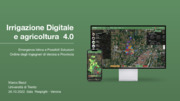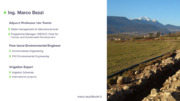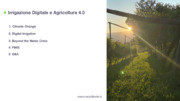Articolo
Irrigazione digitale ed agricoltura 4.0
Emergenza Idrica e Possibili Soluzioni
(PDF in lingua inglese)
1. Climate Change
2. Digital Irrigation
3. Beyond the Water Crisis
4. FMIS - Water and Climate Status Worldwide
Global mean temperature anomalies with respect to the 1850-1900 baseline for the five global temperature datasets
Seasonal variability measures the average within-year variability available water supply including renewable surface and groundwater supplies.
Global drought severity
Future challenges for water use in agriculture
Future Water Shortage
- Coldiretti estimates damage of 2 billion a year due to drought
in agriculture for 2022 in Italy
Possible increase in the price of water
- Cost of the physical good
- Energy costs (from 90 ?/ha in 2020 to 430 ?/ha in 2022)
- Future excise duties for negative externalities
Future implications of Common Agricultural Policy
- 60% of the water used in Italy is demanded by the agro-livestock sector -> new water saving policies in order to access the single payment
The new needs of farmers
Cost Reduction
- Energy costs
- Labour costs
Agile business management
- Remote management of plant and equipment
- Integration of available data for a better business view
Need for irrigation advice
- Climate change and reduced access to water are changing the irrigation paradigms of the past
Digital Irrigation
The integrated use of the latest technologies for intelligent water control to reduce water wastage:
- Data integration
- Use of calculation algorithms
- Use of advanced control tools
The set of HW devices, SW and algorithms capable of bringing additional water savings beyond those already made by water-saving techniques. Typically, digital irrigation is supported by:
- Sensor data: for monitoring soil or plant parameters
- Satellite data: for remote monitoring of soil or plant conditions
- Software and algorithms for interpreting data and extracting farmer usable information such as irrigation advice from the data
- Hardware for controlling irrigation systems
- Quantitative weather forecasts
Digital Irrigation: results
Conventional controlled deficit irrigation:
- crop yield less up to 25%;
- water savings of up to 13%.
Soil moisture sensor controllers 20%-92%
evapotranspiration controllers 20%-71%
Rain sensors 7%-50%
Advantages for farmers
Reducing water wastage
Thanks to the irrigation advice module that communicates with sensors in the field, the farmer is facilitated in administering the right amount of water
Reduced labour and management costs
With remote plant control, the farmer can save on labour and operating costs
Facing new challenges ahead
The new Common Agricultural Policy and the sustainability of production are the main issues that will change due to the lack of
water
(PDF in lingua inglese)
1. Climate Change
2. Digital Irrigation
3. Beyond the Water Crisis
4. FMIS - Water and Climate Status Worldwide
Global mean temperature anomalies with respect to the 1850-1900 baseline for the five global temperature datasets
Seasonal variability measures the average within-year variability available water supply including renewable surface and groundwater supplies.
Global drought severity
Future challenges for water use in agriculture
Future Water Shortage
- Coldiretti estimates damage of 2 billion a year due to drought
in agriculture for 2022 in Italy
Possible increase in the price of water
- Cost of the physical good
- Energy costs (from 90 ?/ha in 2020 to 430 ?/ha in 2022)
- Future excise duties for negative externalities
Future implications of Common Agricultural Policy
- 60% of the water used in Italy is demanded by the agro-livestock sector -> new water saving policies in order to access the single payment
The new needs of farmers
Cost Reduction
- Energy costs
- Labour costs
Agile business management
- Remote management of plant and equipment
- Integration of available data for a better business view
Need for irrigation advice
- Climate change and reduced access to water are changing the irrigation paradigms of the past
Digital Irrigation
The integrated use of the latest technologies for intelligent water control to reduce water wastage:
- Data integration
- Use of calculation algorithms
- Use of advanced control tools
The set of HW devices, SW and algorithms capable of bringing additional water savings beyond those already made by water-saving techniques. Typically, digital irrigation is supported by:
- Sensor data: for monitoring soil or plant parameters
- Satellite data: for remote monitoring of soil or plant conditions
- Software and algorithms for interpreting data and extracting farmer usable information such as irrigation advice from the data
- Hardware for controlling irrigation systems
- Quantitative weather forecasts
Digital Irrigation: results
Conventional controlled deficit irrigation:
- crop yield less up to 25%;
- water savings of up to 13%.
Soil moisture sensor controllers 20%-92%
evapotranspiration controllers 20%-71%
Rain sensors 7%-50%
Advantages for farmers
Reducing water wastage
Thanks to the irrigation advice module that communicates with sensors in the field, the farmer is facilitated in administering the right amount of water
Reduced labour and management costs
With remote plant control, the farmer can save on labour and operating costs
Facing new challenges ahead
The new Common Agricultural Policy and the sustainability of production are the main issues that will change due to the lack of
water
Marco Bezzi - Università di Trento
Guarda tutti i contenuti Università di Trento sul sito SAVE News
Guarda tutti i contenuti Università di Trento sul sito SAVE News
Articoli tecnico scientifici o articoli contenenti case history
SAVE ottobre 2022 Emergenza idrica e possibili soluzioni
Ultimi articoli e atti di convegno
Misura e verifica nei risparmi energetici
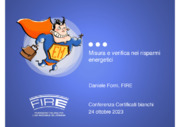
- Misura e verifica
- IPMVP
- Approcci e tipologia di "risparmi"
- Isolamento, possibili casi
I Certificati Bianchi a sostegno dell'efficienza energetica: risultati e strumenti

- L'evoluzione del meccanismo
- Introduzione al meccanismo dei certificati bianchi, cos'è e come funziona
L'Efficienza Energetica nel contesto della nuova direttiva EED e del nuovo PNIEC
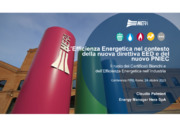
- Nuova Direttiva EED (UE 2023/1791)
L'annoso tema della prova
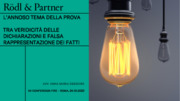
1.1 Una storia unica
1.2 Rödl & Partner nel mondo
1.3 Rödl & Partner in Italia
1.4 I nostri servizi
1.5 I nostri servizi energy
Panoramica sulle guide operative e sugli strumenti a disposizione.

I progetti standardizzati aggiornati e di nuova pubblicazione. Interventi collegati all'efficienza energetica nel settore idrico
D.M. 21 maggio 2021...
Mercato interno dell'energia
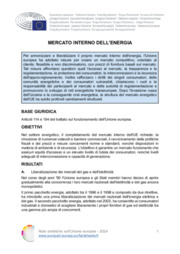
Per armonizzare e liberalizzare il proprio mercato interno dell'energia, l'Unione europea ha adottato misure per creare un mercato competitivo,...
Piccole e Medie Imprese, grandi energie.
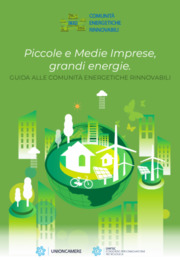
Il presente documento sintetizza lo stato dell'arte delle configurazioni per l'autoconsumo diffuso con un focus operativo sulle Comunità Energetiche...
Le comunità energetiche rinnovabili: sviluppo e quadro normativo
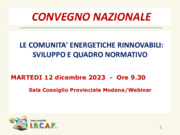
- Il cammino normativo
- IL D. Gls 8/9/2021 N. 199 E LA RED III
- Le regole tecniche
- Il decreto MASE
Analisi del nuovo schema incentivante CER
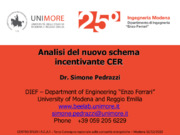
Caratteristiche delle configurazioni e degli impianti ammessi all'incentivo
Modalità di accesso agli incentivi
Caratteristiche dell'incentivo
Caratteristiche termiche dei materiali isolanti sotto la lente
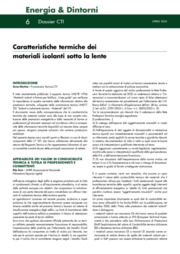
È stato recentemente pubblicato il rapporto tecnico UNI/TR 11936 "Materiali isolanti e finiture per l'edilizia ? Linee guida" per verificare la...
Sistemi di abbattimento fumi/emissioni nocive in accordo con gli standard e le normative locali
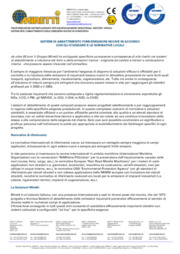
Da oltre 50 anni il Gruppo Miretti ha sviluppato specifiche conoscenze e competenze di alto livello nei sistemi di abbattimento e riduzione dei fumi e...
